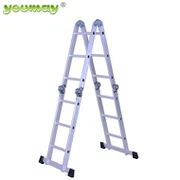What Are The Requirements For The Connection Method And Load-bearing Capacity Of Aluminum Ladders?
Jun 27, 2025
Aluminum ladders are prized for their lightweight strength and corrosion resistance. However, their safe performance hinges critically on two fundamental engineering requirements: robust connection methods and clearly defined load-bearing capacity. Understanding these standards is paramount for user safety.
1. Connection Methods: The Integrity of Joints
The points where ladder components meet – rungs to rails, sections to sections in extension ladders – are potential weak spots. Requirements ensure these connections withstand significant stress:
Primary Methods:
Riveting: The most common method for attaching rungs to side rails. Standards demand:
High-quality aluminum or corrosion-resistant steel rivets.
Correct sizing and sufficient number per rung (typically 2-4).
Secure clinching to prevent loosening under vibration and load.
Smooth finishing to avoid snagging or injury.
Welding: Used less frequently for aluminum due to heat sensitivity affecting material properties. If employed, it must be:
Performed by skilled operators using appropriate techniques (e.g., TIG welding).
Subjected to rigorous non-destructive testing (like dye penetrant or X-ray) to ensure full penetration and lack of cracks or porosity.
Mechanical Fasteners (Bolts/Nuts): Common for attaching accessories, hinges on multi-purpose ladders, or joining extension sections. Requirements include:
Corrosion-resistant hardware (e.g., stainless steel).
Proper torque and locking mechanisms (lock washers, nylon inserts) to prevent vibration-induced loosening.
Smooth heads and recessed points to prevent injury.
Key Requirements Across Methods:
No Movement: Connections must be rigid and prevent any significant play, wobble, or slippage when the ladder is loaded or in use.
Corrosion Resistance: Joints must be protected or made from materials preventing galvanic corrosion between dissimilar metals.
Stress Distribution: Design must distribute load effectively away from connection points to minimize stress concentration.
Durability: Connections must withstand repeated cycles of loading/unloading, setup/storage, and environmental exposure without degradation.
2. Load-Bearing Capacity: The Measure of Strength
This defines the maximum weight a ladder can safely support, including the user, tools, and materials. Requirements are strictly codified:
Duty Rating Classification (Based on ANSI A14.2 / OSHA 1910.23):
Type III (Light Duty): 200 lbs (91 kg) maximum. For household tasks.
Type II (Medium Duty): 225 lbs (102 kg) maximum. For light commercial work.
Type I (Heavy Duty): 250 lbs (113 kg) maximum. For industrial and construction sites.
Type IA (Extra Heavy Duty): 300 lbs (136 kg) maximum. For demanding industrial use.
Type IAA (Special Duty): 375 lbs (170 kg) maximum. Highest capacity for specialized tasks.
Clear Labeling: The duty rating (e.g., "Type IA - 300 lbs") must be permanently and prominently displayed on a side rail near the top.
Testing & Verification:
Ladders undergo rigorous static load tests (e.g., applying 4x the rated load to rungs and side rails) and dynamic drop tests.
Tests simulate worst-case scenarios: ladder at maximum extension, worst angle, point loading on single rungs.
Compliance with ANSI A14.2 (US) or equivalent international standards (like EN 131 in Europe) is mandatory for commercial/industrial ladders.
Why These Requirements Matter:
Ignoring connection integrity or exceeding the load-bearing capacity has dire consequences:
Structural Failure: Loose rivets, cracked welds, or overloaded rungs can lead to sudden collapse.
User Injury: Falls from height are a leading cause of serious workplace and home accidents.
Legal Liability: Using uncertified or overloaded ladders violates OSHA regulations and can void insurance.
Conclusion:
The connection methods and load-bearing capacity are the non-negotiable pillars of aluminum ladder safety. Robust riveting, welding, or bolting ensures structural integrity at critical joints, while clear duty ratings based on rigorous testing define safe operational limits. Always choose a ladder certified to ANSI A14.2 or EN 131, visibly labeled with its Type/rating, and never exceed that capacity. Inspect connections regularly for signs of wear, damage, or looseness. Understanding and respecting these requirements is fundamental to preventing accidents and ensuring safe ascents.







